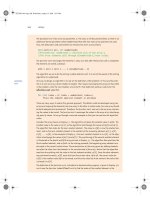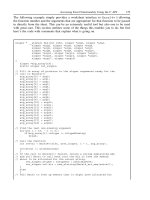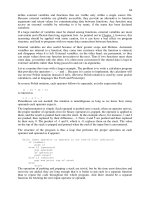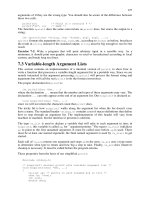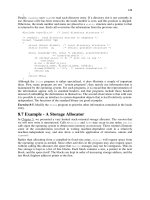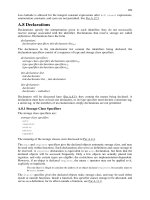the ansi c programming phần 6 docx
Bạn đang xem bản rút gọn của tài liệu. Xem và tải ngay bản đầy đủ của tài liệu tại đây (213.87 KB, 21 trang )
106
struct{ }x,y,z;
issyntacticallyanalogousto
intx,y,z;
in the sense that each statement declares
x
,
y
and
z
to be variables of the named type and
causesspacetobesetasideforthem.
A structure declaration that is not followed by a list of variables reserves no storage; it merely
describes a template or shape of a structure. If the declaration is tagged, however, the tag can
be used later in definitions of instances of the structure. For example, given the declaration of
point
above,
structpointpt;
defines a variable
pt
which is a structure of type
struct point
. A structure can be
initialized by following its definition with a list of initializers, each a constant expression, for
themembers:
structmaxpt={320,200};
An automatic structure may also be initialized by assignment or by calling a function that
returnsastructureoftherighttype.
A member of a particular structure is referred to in an expression by a construction of the
form
structure-name.member
The structure member operator ``.''connects the structure name and the member name. To
printthecoordinatesofthepoint
pt
,forinstance,
printf("%d,%d",pt.x,pt.y);
ortocomputethedistancefromtheorigin(0,0)to
pt
,
doubledist,sqrt(double);
dist=sqrt((double)pt.x*pt.x+(double)pt.y*pt.y);
Structures can be nested. One representation of a rectangle is a pair of points that denote the
diagonallyoppositecorners:
structrect{
structpointpt1;
structpointpt2;
};
The
rect
structurecontainstwo
point
structures.Ifwedeclare
screen
as
structrectscreen;
then
screen.pt1.x
107
referstothexcoordinateofthe
pt1
memberof
screen
.
6.2StructuresandFunctions
The only legal operations on a structure are copying it or assigning to it as a unit, taking its
address with
&
, and accessing its members. Copy and assignment include passing arguments
to functions and returning values from functions as well. Structures may not be compared. A
structure may be initialized by a list of constant member values; an automatic structure may
alsobeinitializedbyanassignment.
Let us investigate structures by writing some functions to manipulate points and rectangles.
There are at least three possible approaches: pass components separately, pass an entire
structure,orpassapointertoit.Eachhasitsgoodpointsandbadpoints.
Thefirstfunction,
makepoint
,willtaketwointegersandreturna
point
structure:
/*makepoint:makeapointfromxandycomponents*/
structpointmakepoint(intx,inty)
{
structpointtemp;
temp.x=x;
temp.y=y;
returntemp;
}
Notice that there is no conflict between the argument name and the member with the same
name;indeedthere-useofthenamesstressestherelationship.
makepoint
can now be used to initialize any structure dynamically, or to provide structure
argumentstoafunction:
structrectscreen;
structpointmiddle;
structpointmakepoint(int,int);
screen.pt1=makepoint(0,0);
screen.pt2=makepoint(XMAX,YMAX);
middle=makepoint((screen.pt1.x+screen.pt2.x)/2,
(screen.pt1.y+screen.pt2.y)/2);
Thenextstepisasetoffunctionstodoarithmeticonpoints.Forinstance,
/*addpoints:addtwopoints*/
structaddpoint(structpointp1,structpointp2)
{
p1.x+=p2.x;
p1.y+=p2.y;
returnp1;
}
Here both the arguments and the return value are structures. We incremented the components
in
p1
rather than using an explicit temporary variable to emphasize that structure parameters
arepassedbyvaluelikeanyothers.
As another example, the function
ptinrect
tests whether a point is inside a rectangle, where
we have adopted the convention that a rectangle includes its left and bottom sides but not its
topandrightsides:
/*ptinrect:return1ifpinr,0ifnot*/
intptinrect(structpointp,structrectr)
{
returnp.x>=r.pt1.x&&p.x<r.pt2.x
&&p.y>=r.pt1.y&&p.y<r.pt2.y;
}
108
This assumes that the rectangle is presented in a standard form where the
pt1
coordinates are
less than the
pt2
coordinates. The following function returns a rectangle guaranteed to be in
canonicalform:
#definemin(a,b)((a)<(b)?(a):(b))
#definemax(a,b)((a)>(b)?(a):(b))
/*canonrect:canonicalizecoordinatesofrectangle*/
structrectcanonrect(structrectr)
{
structrecttemp;
temp.pt1.x=min(r.pt1.x,r.pt2.x);
temp.pt1.y=min(r.pt1.y,r.pt2.y);
temp.pt2.x=max(r.pt1.x,r.pt2.x);
temp.pt2.y=max(r.pt1.y,r.pt2.y);
returntemp;
}
If a large structure is to be passed to a function, it is generally more efficient to pass a pointer
than to copy the whole structure. Structure pointers are just like pointers to ordinary
variables.Thedeclaration
structpoint*pp;
says that
pp
is a pointer to a structure of type
struct point
. If
pp
points to a
point
structure,
*pp
is the structure, and
(*pp).x
and
(*pp).y
are the members. To use
pp
, we
mightwrite,forexample,
structpointorigin,*pp;
pp=&origin;
printf("originis(%d,%d)\n",(*pp).x,(*pp).y);
The parentheses are necessary in
(*pp).x
because the precedence of the structure member
operator
.
is higher then
*
. The expression
*pp.x
means
*(pp.x)
, which is illegal here
because
x
isnotapointer.
Pointers to structures are so frequently used that an alternative notation is provided as a
shorthand.If
p
isapointertoastructure,then
p->member-of-structure
referstotheparticularmember.Sowecouldwriteinstead
printf("originis(%d,%d)\n",pp->x,pp->y);
Both
.
and
->
associatefromlefttoright,soifwehave
structrectr,*rp=&r;
thenthesefourexpressionsareequivalent:
r.pt1.x
rp->pt1.x
(r.pt1).x
(rp->pt1).x
The structure operators
.
and
->
, together with
()
for function calls and
[]
for subscripts, are
at the top of the precedence hierarchy and thus bind very tightly. For example, given the
declaration
struct{
intlen;
char*str;
}*p;
then
++p->len
109
increments
len
, not
p
, because the implied parenthesization is
++(p->len)
. Parentheses can
be used to alter binding:
(++p)->len
increments
p
before accessing
len
, and
(p++)->len
increments
p
afterward.(Thislastsetofparenthesesisunnecessary.)
In the same way,
*p->str
fetches whatever
str
points to;
*p->str++
increments
str
after
accessing whatever it points to (just like
*s++
);
(*p->str)++
increments whatever
str
points
to;and
*p++->str
increments
p
afteraccessingwhatever
str
pointsto.
6.3ArraysofStructures
Consider writing a program to count the occurrences of each C keyword. We need an array of
character strings to hold the names, and an array of integers for the counts. One possibility is
tousetwoparallelarrays,
keyword
and
keycount
,asin
char*keyword[NKEYS];
intkeycount[NKEYS];
But the very fact that the arrays are parallel suggests a different organization, an array of
structures.Eachkeywordisapair:
char*word;
intcout;
andthereisanarrayofpairs.Thestructuredeclaration
structkey{
char*word;
intcount;
}keytab[NKEYS];
declares a structure type
key
, defines an array
keytab
of structures of this type, and sets aside
storageforthem.Eachelementofthearrayisastructure.Thiscouldalsobewritten
structkey{
char*word;
intcount;
};
structkeykeytab[NKEYS];
Since the structure
keytab
contains a constant set of names, it is easiest to make it an external
variable and initialize it once and for all when it is defined. The structure initialization is
analogous to earlier ones - the definition is followed by a list of initializers enclosed in
braces:
structkey{
char*word;
intcount;
}keytab[]={
"auto",0,
"break",0,
"case",0,
"char",0,
"const",0,
"continue",0,
"default",0,
/* */
"unsigned",0,
"void",0,
"volatile",0,
"while",0
};
The initializers are listed in pairs corresponding to the structure members. It would be more
precisetoenclosetheinitializersforeach"row"orstructureinbraces,asin
{"auto",0},
{"break",0},
110
{"case",0},
but inner braces are not necessary when the initializers are simple variables or character
strings, and when all are present. As usual, the number of entries in the array
keytab
will be
computediftheinitializersarepresentandthe
[]
isleftempty.
The keyword counting program begins with the definition of
keytab
. The main routine reads
the input by repeatedly calling a function
getword
that fetches one word at a time. Each word
is looked up in
keytab
with a version of the binary search function that we wrote in Chapter
3.Thelistofkeywordsmustbesortedinincreasingorderinthetable.
#include<stdio.h>
#include<ctype.h>
#include<string.h>
#defineMAXWORD100
intgetword(char*,int);
intbinsearch(char*,structkey*,int);
/*countCkeywords*/
main()
{
intn;
charword[MAXWORD];
while(getword(word,MAXWORD)!=EOF)
if(isalpha(word[0]))
if((n=binsearch(word,keytab,NKEYS))>=0)
keytab[n].count++;
for(n=0;n<NKEYS;n++)
if(keytab[n].count>0)
printf("%4d%s\n",
keytab[n].count,keytab[n].word);
return0;
}
/*binsearch:findwordintab[0] tab[n-1]*/
intbinsearch(char*word,structkeytab[],intn)
{
intcond;
intlow,high,mid;
low=0;
high=n-1;
while(low<=high){
mid=(low+high)/2;
if((cond=strcmp(word,tab[mid].word))<0)
high=mid-1;
elseif(cond>0)
low=mid+1;
else
returnmid;
}
return-1;
}
We will show the function
getword
in a moment; for now it suffices to say that each call to
getword
findsaword,whichiscopiedintothearraynamedasitsfirstargument.
The quantity
NKEYS
is the number of keywords in
keytab
. Although we could count this by
hand, it's a lot easier and safer to do it by machine, especially if the list is subject to change.
One possibility would be to terminate the list of initializers with a null pointer, then loop
along
keytab
untiltheendisfound.
111
But this is more than is needed, since the size of the array is completely determined at
compile time. The size of the array is the size of one entry times the number of entries, so the
numberofentriesisjust
sizeof
keytab/
sizeof
structkey
C provides a compile-time unary operator called
sizeof
that can be used to compute the size
ofanyobject.Theexpressions
sizeofobject
and
sizeof(typename)
yield an integer equal to the size of the specified object or type in bytes. (Strictly,
sizeof
produces an unsigned integer value whose type,
size_t
, is defined in the header
<stddef.h>
.) An object can be a variable or array or structure. A type name can be the name
ofabasictypelike
int
or
double
,oraderivedtypelikeastructureorapointer.
In our case, the number of keywords is the size of the array divided by the size of one
element.Thiscomputationisusedina
#define
statementtosetthevalueof
NKEYS
:
#defineNKEYS(sizeofkeytab/sizeof(structkey))
Anotherwaytowritethisistodividethearraysizebythesizeofaspecificelement:
#defineNKEYS(sizeofkeytab/sizeof(keytab[0]))
Thishastheadvantagethatitdoesnotneedtobechangedifthetypechanges.
A
sizeof
can not be used in a
#if
line, because the preprocessor does not parse type names.
But the expression in the
#define
is not evaluated by the preprocessor, so the code here is
legal.
Nowforthefunction
getword
.Wehavewrittenamoregeneral
getword
thanisnecessaryfor
this program, but it is not complicated.
getword
fetches the next ``word''from the input,
where a word is either a string of letters and digits beginning with a letter, or a single non-
white space character. The function value is the first character of the word, or
EOF
for end of
file,orthecharacteritselfifitisnotalphabetic.
/*getword:getnextwordorcharacterfrominput*/
intgetword(char*word,intlim)
{
intc,getch(void);
voidungetch(int);
char*w=word;
while(isspace(c=getch()))
;
if(c!=EOF)
*w++=c;
if(!isalpha(c)){
*w='\0';
returnc;
}
for(; lim>0;w++)
if(!isalnum(*w=getch())){
ungetch(*w);
break;
}
*w='\0';
returnword[0];
}
112
getword
uses the
getch
and
ungetch
that we wrote in Chapter4. When the collection of an
alphanumeric token stops,
getword
has gone one character too far. The call to
ungetch
pushes that character back on the input for the next call.
getword
also uses
isspace
to skip
whitespace,
isalpha
toidentifyletters,and
isalnum
toidentifylettersanddigits;allarefrom
thestandardheader
<ctype.h>
.
Exercise 6-1. Our version of
getword
does not properly handle underscores, string constants,
comments,orpreprocessorcontrollines.Writeabetterversion.
6.4PointerstoStructures
To illustrate some of the considerations involved with pointers to and arrays of structures, let
us write the keyword-counting program again, this time using pointers instead of array
indices.
The external declaration of
keytab
need not change, but
main
and
binsearch
do need
modification.
#include<stdio.h>
#include<ctype.h>
#include<string.h>
#defineMAXWORD100
intgetword(char*,int);
structkey*binsearch(char*,structkey*,int);
/*countCkeywords;pointerversion*/
main()
{
charword[MAXWORD];
structkey*p;
while(getword(word,MAXWORD)!=EOF)
if(isalpha(word[0]))
if((p=binsearch(word,keytab,NKEYS))!=NULL)
p->count++;
for(p=keytab;p<keytab+NKEYS;p++)
if(p->count>0)
printf("%4d%s\n",p->count,p->word);
return0;
}
/*binsearch:findwordintab[0] tab[n-1]*/
structkey*binsearch(char*word,struckkey*tab,intn)
{
intcond;
structkey*low=&tab[0];
structkey*high=&tab[n];
structkey*mid;
while(low<high){
mid=low+(high-low)/2;
if((cond=strcmp(word,mid->word))<0)
high=mid;
elseif(cond>0)
low=mid+1;
else
returnmid;
}
returnNULL;
}
There are several things worthy of note here. First, the declaration of
binsearch
must
indicate that it returns a pointer to
struct key
instead of an integer; this is declared both in
113
the function prototype and in
binsearch
. If
binsearch
finds the word, it returns a pointer to
it;ifitfails,itreturns
NULL
.
Second, the elements of
keytab
are now accessed by pointers. This requires significant
changesin
binsearch
.
The initializers for
low
and
high
are now pointers to the beginning and just past the end of
thetable.
Thecomputationofthemiddleelementcannolongerbesimply
mid=(low+high)/2/*WRONG*/
because the addition of pointers is illegal. Subtraction is legal, however, so
high-low
is the
numberofelements,andthus
mid=low+(high-low)/2
sets
mid
totheelementhalfwaybetween
low
and
high
.
The most important change is to adjust the algorithm to make sure that it does not generate an
illegal pointer or attempt to access an element outside the array. The problem is that
&tab[-
1]
and
&tab[n]
are both outside the limits of the array
tab
. The former is strictly illegal, and
it is illegal to dereference the latter. The language definition does guarantee, however, that
pointer arithmetic that involves the first element beyond the end of an array (that is,
&tab[n]
)
willworkcorrectly.
In
main
wewrote
for(p=keytab;p<keytab+NKEYS;p++)
If
p
is a pointer to a structure, arithmetic on
p
takes into account the size of the structure, so
p++
increments
p
by the correct amount to get the next element of the array of structures, and
theteststopstheloopattherighttime.
Don't assume, however, that the size of a structure is the sum of the sizes of its members.
Because of alignment requirements for different objects, there may be unnamed ``holes''in a
structure.Thus,forinstance,ifa
char
isonebyteandan
int
fourbytes,thestructure
struct{
charc;
inti;
};
mightwellrequireeightbytes,notfive.The
sizeof
operatorreturnsthepropervalue.
Finally, an aside on program format: when a function returns a complicated type like a
structurepointer,asin
structkey*binsearch(char*word,structkey*tab,intn)
the function name can be hard to see, and to find with a text editor. Accordingly an alternate
styleissometimesused:
structkey*
binsearch(char*word,structkey*tab,intn)
Thisisamatterofpersonaltaste;picktheformyoulikeandholdtoit.
6.5Self-referentialStructures
Suppose we want to handle the more general problem of counting the occurrences of all the
words in some input. Since the list of words isn't known in advance, we can't conveniently
sort it and use a binary search. Yet we can't do a linear search for each word as it arrives, to
see if it's already been seen; the program would take too long. (More precisely, its running
114
time is likely to grow quadratically with the number of input words.) How can we organize
thedatatocopyefficientlywithalistorarbitrarywords?
One solution is to keep the set of words seen so far sorted at all times, by placing each word
into its proper position in the order as it arrives. This shouldn't be done by shifting words in a
linear array, though - that also takes too long. Instead we will use a data structure called a
binarytree.
Thetreecontainsone``node''perdistinctword;eachnodecontains
•
Apointertothetextoftheword,
•
Acountofthenumberofoccurrences,
•
Apointertotheleftchildnode,
•
Apointertotherightchildnode.
Nonodemayhavemorethantwochildren;itmighthaveonlyzeroorone.
The nodes are maintained so that at any node the left subtree contains only words that are
lexicographically less than the word at the node, and the right subtree contains only words
that are greater. This is the tree for the sentence ``now is the time for all good men to come to
theaidoftheirparty'',asbuiltbyinsertingeachwordasitisencountered:
To find out whether a new word is already in the tree, start at the root and compare the new
word to the word stored at that node. If they match, the question is answered affirmatively. If
the new record is less than the tree word, continue searching at the left child, otherwise at the
right child. If there is no child in the required direction, the new word is not in the tree, and in
fact the empty slot is the proper place to add the new word. This process is recursive, since
the search from any node uses a search from one of its children. Accordingly, recursive
routinesforinsertionandprintingwillbemostnatural.
Going back to the description of a node, it is most conveniently represented as a structure
withfourcomponents:
structtnode{/*thetreenode:*/
char*word;/*pointstothetext*/
intcount;/*numberofoccurrences*/
structtnode*left;/*leftchild*/
structtnode*right;/*rightchild*/
};
This recursive declaration of a node might look chancy, but it's correct. It is illegal for a
structuretocontainaninstanceofitself,but
structtnode*left;
115
declares
left
tobeapointertoa
tnode
,nota
tnode
itself.
Occasionally, one needs a variation of self-referential structures: two structures that refer to
eachother.Thewaytohandlethisis:
structt{
structs*p;/*ppointstoans*/
};
structs{
structt*q;/*qpointstoat*/
};
The code for the whole program is surprisingly small, given a handful of supporting routines
like
getword
that we have already written. The main routine reads words with
getword
and
installstheminthetreewith
addtree
.
#include<stdio.h>
#include<ctype.h>
#include<string.h>
#defineMAXWORD100
structtnode*addtree(structtnode*,char*);
voidtreeprint(structtnode*);
intgetword(char*,int);
/*wordfrequencycount*/
main()
{
structtnode*root;
charword[MAXWORD];
root=NULL;
while(getword(word,MAXWORD)!=EOF)
if(isalpha(word[0]))
root=addtree(root,word);
treeprint(root);
return0;
}
The function
addtree
is recursive. A word is presented by
main
to the top level (the root) of
the tree. At each stage, that word is compared to the word already stored at the node, and is
percolated down to either the left or right subtree by a recursive call to
adtree
. Eventually,
the word either matches something already in the tree (in which case the count is
incremented), or a null pointer is encountered, indicating that a node must be created and
added to the tree. If a new node is created,
addtree
returns a pointer to it, which is installed
intheparentnode.
structtnode*talloc(void);
char*strdup(char*);
/*addtree:addanodewithw,atorbelowp*/
structtreenode*addtree(structtnode*p,char*w)
{
intcond;
if(p==NULL){/*anewwordhasarrived*/
p=talloc();/*makeanewnode*/
p->word=strdup(w);
p->count=1;
p->left=p->right=NULL;
}elseif((cond=strcmp(w,p->word))==0)
p->count++;/*repeatedword*/
elseif(cond<0)/*lessthanintoleftsubtree*/
p->left=addtree(p->left,w);
116
else/*greaterthanintorightsubtree*/
p->right=addtree(p->right,w);
returnp;
}
Storage for the new node is fetched by a routine
talloc
, which returns a pointer to a free
space suitable for holding a tree node, and the new word is copied into a hidden space by
strdup
. (We will discuss these routines in a moment.) The count is initialized, and the two
children are made null. This part of the code is executed only at the leaves of the tree, when a
new node is being added. We have (unwisely) omitted error checking on the values returned
by
strdup
and
talloc
.
treeprint
prints the tree in sorted order; at each node, it prints the left subtree (all the words
less than this word), then the word itself, then the right subtree (all the words greater). If you
feel shaky about how recursion works, simulate
treeprint
as it operates on the tree shown
above.
/*treeprint:in-orderprintoftreep*/
voidtreeprint(structtnode*p)
{
if(p!=NULL){
treeprint(p->left);
printf("%4d%s\n",p->count,p->word);
treeprint(p->right);
}
}
A practical note: if the tree becomes ``unbalanced''because the words don't arrive in random
order, the running time of the program can grow too much. As a worst case, if the words are
already in order, this program does an expensive simulation of linear search. There are
generalizations of the binary tree that do not suffer from this worst-case behavior, but we will
notdescribethemhere.
Before leaving this example, it is also worth a brief digression on a problem related to storage
allocators. Clearly it's desirable that there be only one storage allocator in a program, even
though it allocates different kinds of objects. But if one allocator is to process requests for,
say, pointers to
char
s and pointers to
struct tnode
s, two questions arise. First, how does it
meet the requirement of most real machines that objects of certain types must satisfy
alignment restrictions (for example, integers often must be located at even addresses)?
Second, what declarations can cope with the fact that an allocator must necessarily return
differentkindsofpointers?
Alignment requirements can generally be satisfied easily, at the cost of some wasted space,
by ensuring that the allocator always returns a pointer that meets all alignment restrictions.
The
alloc
of Chapter 5 does not guarantee any particular alignment, so we will use the
standard library function
malloc
, which does. In Chapter 8 we will show one way to
implement
malloc
.
The question of the type declaration for a function like
malloc
is a vexing one for any
language that takes its type-checking seriously. In C, the proper method is to declare that
malloc
returns a pointer to
void
, then explicitly coerce the pointer into the desired type with
a cast.
malloc
and related routines are declared in the standard header
<stdlib.h>
. Thus
talloc
canbewrittenas
#include<stdlib.h>
/*talloc:makeatnode*/
structtnode*talloc(void)
{
return(structtnode*)malloc(sizeof(structtnode));
}
117
strdup
merelycopiesthestringgivenbyitsargumentintoasafeplace,obtainedbyacallon
malloc
:
char*strdup(char*s)/*makeaduplicateofs*/
{
char*p;
p=(char*)malloc(strlen(s)+1);/*+1for'\0'*/
if(p!=NULL)
strcpy(p,s);
returnp;
}
malloc
returns
NULL
if no space is available;
strdup
passes that value on, leaving error-
handlingtoitscaller.
Storage obtained by calling
malloc
may be freed for re-use by calling
free
; see Chapters8
and7.
Exercise 6-2. Write a program that reads a C program and prints in alphabetical order each
group of variable names that are identical in the first 6 characters, but different somewhere
thereafter. Don't count words within strings and comments. Make 6 a parameter that can be
setfromthecommandline.
Exercise 6-3. Write a cross-referencer that prints a list of all words in a document, and for
each word, a list of the line numbers on which it occurs. Remove noise words like ``the,''
``and,''andsoon.
Exercise 6-4. Write a program that prints the distinct words in its input sorted into decreasing
orderoffrequencyofoccurrence.Precedeeachwordbyitscount.
6.6TableLookup
In this section we will write the innards of a table-lookup package, to illustrate more aspects
of structures. This code is typical of what might be found in the symbol table management
routines of a macro processor or a compiler. For example, consider the
#define
statement.
Whenalinelike
#defineIN1
is encountered, the name
IN
and the replacement text
1
are stored in a table. Later, when the
name
IN
appearsinastatementlike
state=IN;
itmustbereplacedby
1
.
There are two routines that manipulate the names and replacement texts.
install(s,t)
records the name
s
and the replacement text
t
in a table;
s
and
t
are just character strings.
lookup(s)
searches for
s
in the table, and returns a pointer to the place where it was found,
or
NULL
ifitwasn'tthere.
The algorithm is a hash-search - the incoming name is converted into a small non-negative
integer, which is then used to index into an array of pointers. An array element points to the
beginning of a linked list of blocks describing names that have that hash value. It is
NULL
if
nonameshavehashedtothatvalue.
118
A block in the list is a structure containing pointers to the name, the replacement text, and the
nextblockinthelist.Anullnext-pointermarkstheendofthelist.
structnlist{/*tableentry:*/
structnlist*next;/*nextentryinchain*/
char*name;/*definedname*/
char*defn;/*replacementtext*/
};
Thepointerarrayisjust
#defineHASHSIZE101
staticstructnlist*hashtab[HASHSIZE];/*pointertable*/
The hashing function, which is used by both
lookup
and
install
, adds each character value
in the string to a scrambled combination of the previous ones and returns the remainder
modulothearraysize.Thisisnotthebestpossiblehashfunction,butitisshortandeffective.
/*hash:formhashvalueforstrings*/
unsignedhash(char*s)
{
unsignedhashval;
for(hashval=0;*s!='\0';s++)
hashval=*s+31*hashval;
returnhashval%HASHSIZE;
}
Unsignedarithmeticensuresthatthehashvalueisnon-negative.
The hashing process produces a starting index in the array
hashtab
; if the string is to be
found anywhere, it will be in the list of blocks beginning there. The search is performed by
lookup
. If
lookup
finds the entry already present, it returns a pointer to it; if not, it returns
NULL
.
/*lookup:lookforsinhashtab*/
structnlist*lookup(char*s)
{
structnlist*np;
for(np=hashtab[hash(s)];np!=NULL;np=np->next)
if(strcmp(s,np->name)==0)
returnnp;/*found*/
returnNULL;/*notfound*/
}
The
for
loopin
lookup
isthestandardidiomforwalkingalongalinkedlist:
for(ptr=head;ptr!=NULL;ptr=ptr->next)
119
install
uses
lookup
to determine whether the name being installed is already present; if so,
the new definition will supersede the old one. Otherwise, a new entry is created.
install
returns
NULL
ifforanyreasonthereisnoroomforanewentry.
structnlist*lookup(char*);
char*strdup(char*);
/*install:put(name,defn)inhashtab*/
structnlist*install(char*name,char*defn)
{
structnlist*np;
unsignedhashval;
if((np=lookup(name))==NULL){/*notfound*/
np=(structnlist*)malloc(sizeof(*np));
if(np==NULL||(np->name=strdup(name))==NULL)
returnNULL;
hashval=hash(name);
np->next=hashtab[hashval];
hashtab[hashval]=np;
}else/*alreadythere*/
free((void*)np->defn);/*freepreviousdefn*/
if((np->defn=strdup(defn))==NULL)
returnNULL;
returnnp;
}
Exercise 6-5. Write a function
undef
that will remove a name and definition from the table
maintainedby
lookup
and
install
.
Exercise 6-6. Implement a simple version of the
#define
processor (i.e., no arguments)
suitable for use with C programs, based on the routines of this section. You may also find
getch
and
ungetch
helpful.
6.7Typedef
C provides a facility called
typedef
for creating new data type names. For example, the
declaration
typedefintLength;
makes the name
Length
a synonym for
int
. The type
Length
can be used in declarations,
casts,etc.,inexactlythesamewaysthatthe
int
typecanbe:
Lengthlen,maxlen;
Length*lengths[];
Similarly,thedeclaration
typedefchar*String;
makes
String
a synonym for
char *
or character pointer, which may then be used in
declarationsandcasts:
Stringp,lineptr[MAXLINES],alloc(int);
intstrcmp(String,String);
p=(String)malloc(100);
Notice that the type being declared in a
typedef
appears in the position of a variable name,
not right after the word
typedef
. Syntactically,
typedef
is like the storage classes
extern
,
static
,etc.Wehaveusedcapitalizednamesfor
typedef
s,tomakethemstandout.
As a more complicated example, we could make
typedef
s for the tree nodes shown earlier in
thischapter:
typedefstructtnode*Treeptr;
typedefstructtnode{/*thetreenode:*/
120
char*word;/*pointstothetext*/
intcount;/*numberofoccurrences*/
structtnode*left;/*leftchild*/
structtnode*right;/*rightchild*/
}Treenode;
This creates two new type keywords called
Treenode
(a structure) and
Treeptr
(a pointer to
thestructure).Thentheroutine
talloc
couldbecome
Treeptrtalloc(void)
{
return(Treeptr)malloc(sizeof(Treenode));
}
It must be emphasized that a
typedef
declaration does not create a new type in any sense; it
merely adds a new name for some existing type. Nor are there any new semantics: variables
declared this way have exactly the same properties as variables whose declarations are
spelled out explicitly. In effect,
typedef
is like
#define
, except that since it is interpreted by
the compiler, it can cope with textual substitutions that are beyond the capabilities of the
preprocessor.Forexample,
typedefint(*PFI)(char*,char*);
creates the type
PFI
, for ``pointer to function (of two
char *
arguments) returning
int
,''
whichcanbeusedincontextslike
PFIstrcmp,numcmp;
inthesortprogramofChapter5.
Besides purely aesthetic issues, there are two main reasons for using
typedef
s. The first is to
parameterize a program against portability problems. If
typedef
s are used for data types that
may be machine-dependent, only the
typedef
s need change when the program is moved.
One common situation is to use
typedef
names for various integer quantities, then make an
appropriate set of choices of
short
,
int
, and
long
for each host machine. Types like
size_t
and
ptrdiff_t
fromthestandardlibraryareexamples.
The second purpose of
typedef
s is to provide better documentation for a program - a type
called
Treeptr
may be easier to understand than one declared only as a pointer to a
complicatedstructure.
6.8Unions
A union is a variable that may hold (at different times) objects of different types and sizes,
with the compiler keeping track of size and alignment requirements. Unions provide a way to
manipulate different kinds of data in a single area of storage, without embedding any
machine-dependent information in the program. They are analogous to variant records in
pascal.
As an example such as might be found in a compiler symbol table manager, suppose that a
constant may be an
int
, a
float
, or a character pointer. The value of a particular constant
must be stored in a variable of the proper type, yet it is most convenient for table
management if the value occupies the same amount of storage and is stored in the same place
regardless of its type. This is the purpose of a union - a single variable that can legitimately
holdanyofoneofseveraltypes.Thesyntaxisbasedonstructures:
unionu_tag{
intival;
floatfval;
char*sval;
}u;
The variable
u
will be large enough to hold the largest of the three types; the specific size is
implementation-dependent. Any of these types may be assigned to
u
and then used in
121
expressions, so long as the usage is consistent: the type retrieved must be the type most
recently stored. It is the programmer's responsibility to keep track of which type is currently
stored in a union; the results are implementation-dependent if something is stored as one type
andextractedasanother.
Syntactically,membersofaunionareaccessedas
union-name
.
member
or
union-pointer
->
member
just as for structures. If the variable
utype
is used to keep track of the current type stored in
u
,thenonemightseecodesuchas
if(utype==INT)
printf("%d\n",u.ival);
if(utype==FLOAT)
printf("%f\n",u.fval);
if(utype==STRING)
printf("%s\n",u.sval);
else
printf("badtype%dinutype\n",utype);
Unions may occur within structures and arrays, and vice versa. The notation for accessing a
member of a union in a structure (or vice versa) is identical to that for nested structures. For
example,inthestructurearraydefinedby
struct{
char*name;
intflags;
intutype;
union{
intival;
floatfval;
char*sval;
}u;
}symtab[NSYM];
themember
ival
isreferredtoas
symtab[i].u.ival
andthefirstcharacterofthestring
sval
byeitherof
*symtab[i].u.sval
symtab[i].u.sval[0]
In effect, a union is a structure in which all members have offset zero from the base, the
structure is big enough to hold the ``widest''member, and the alignment is appropriate for all
of the types in the union. The same operations are permitted on unions as on structures:
assignmenttoorcopyingasaunit,takingtheaddress,andaccessingamember.
A union may only be initialized with a value of the type of its first member; thus union
u
describedabovecanonlybeinitializedwithanintegervalue.
The storage allocator in Chapter8 shows how a union can be used to force a variable to be
alignedonaparticularkindofstorageboundary.
6.9Bit-fields
When storage space is at a premium, it may be necessary to pack several objects into a single
machine word; one common use is a set of single-bit flags in applications like compiler
122
symbol tables. Externally-imposed data formats, such as interfaces to hardware devices, also
oftenrequiretheabilitytogetatpiecesofaword.
Imagine a fragment of a compiler that manipulates a symbol table. Each identifier in a
program has certain information associated with it, for example, whether or not it is a
keyword, whether or not it is external and/or static, and so on. The most compact way to
encodesuchinformationisasetofone-bitflagsinasingle
char
or
int
.
The usual way this is done is to define a set of ``masks''corresponding to the relevant bit
positions,asin
#defineKEYWORD01
#defineEXTRENAL02
#defineSTATIC04
or
enum{KEYWORD=01,EXTERNAL=02,STATIC=04};
The numbers must be powers of two. Then accessing the bits becomes a matter of ``bit-
fiddling''with the shifting, masking, and complementing operators that were described in
Chapter2.
Certainidiomsappearfrequently:
flags|=EXTERNAL|STATIC;
turnsonthe
EXTERNAL
and
STATIC
bitsin
flags
,while
flags&=~(EXTERNAL|STATIC);
turnsthemoff,and
if((flags&(EXTERNAL|STATIC))==0)
istrueifbothbitsareoff.
Although these idioms are readily mastered, as an alternative C offers the capability of
defining and accessing fields within a word directly rather than by bitwise logical operators.
A bit-field, or field for short, is a set of adjacent bits within a single implementation-defined
storage unit that we will call a ``word.''For example, the symbol table
#define
s above could
bereplacedbythedefinitionofthreefields:
struct{
unsignedintis_keyword:1;
unsignedintis_extern:1;
unsignedintis_static:1;
}flags;
This defines a variable table called
flags
that contains three 1-bit fields. The number
following the colon represents the field width in bits. The fields are declared
unsigned int
toensurethattheyareunsignedquantities.
Individual fields are referenced in the same way as other structure members:
flags.is_keyword
,
flags.is_extern
, etc. Fields behave like small integers, and may
participate in arithmetic expressions just like other integers. Thus the previous examples may
bewrittenmorenaturallyas
flags.is_extern=flags.is_static=1;
toturnthebitson;
flags.is_extern=flags.is_static=0;
toturnthemoff;and
if(flags.is_extern==0&&flags.is_static==0)
123
totestthem.
Almost everything about fields is implementation-dependent. Whether a field may overlap a
wordboundaryisimplementation-defined.Fieldsneednotbenames;unnamedfields(acolon
and width only) are used for padding. The special width 0 may be used to force alignment at
thenextwordboundary.
Fields are assigned left to right on some machines and right to left on others. This means that
although fields are useful for maintaining internally-defined data structures, the question of
which end comes first has to be carefully considered when picking apart externally-defined
data; programs that depend on such things are not portable. Fields may be declared only as
int
s; for portability, specify
signed
or
unsigned
explicitly. They are not arrays and they do
nothaveaddresses,sothe
&
operatorcannotbeappliedonthem.
124
Chapter7-InputandOutput
Input and output are not part of the C language itself, so we have not emphasized them in our
presentation thus far. Nonetheless, programs interact with their environment in much more
complicated ways than those we have shown before. In this chapter we will describe the
standard library, a set of functions that provide input and output, string handling, storage
management, mathematical routines, and a variety of other services for C programs. We will
concentrateoninputandoutput
The ANSI standard defines these library functions precisely, so that they can exist in
compatible form on any system where C exists. Programs that confine their system
interactions to facilities provided by the standard library can be moved from one system to
anotherwithoutchange.
The properties of library functions are specified in more than a dozen headers; we have
already seen several of these, including
<stdio.h>
,
<string.h>
, and
<ctype.h>
. We will
notpresenttheentirelibraryhere,sincewearemoreinterestedinwritingCprogramsthatuse
it.ThelibraryisdescribedindetailinAppendixB.
7.1StandardInputandOutput
As we said in Chapter1, the library implements a simple model of text input and output. A
text stream consists of a sequence of lines; each line ends with a newline character. If the
system doesn't operate that way, the library does whatever necessary to make it appear as if it
does. For instance, the library might convert carriage return and linefeed to newline on input
andbackagainonoutput.
The simplest input mechanism is to read one character at a time from the standard input,
normallythekeyboard,with
getchar
:
intgetchar(void)
getchar
returns the next input character each time it is called, or
EOF
when it encounters end
of file. The symbolic constant
EOF
is defined in
<stdio.h>
. The value is typically -1, bus
testsshouldbewrittenintermsof
EOF
soastobeindependentofthespecificvalue.
In many environments, a file may be substituted for the keyboard by using the < convention
forinputredirection:ifaprogram
prog
uses
getchar
,thenthecommandline
prog<infile
causes
prog
to read characters from
infile
instead. The switching of the input is done in
such a way that
prog
itself is oblivious to the change; in particular, the string ``
<infile
''is
not included in the command-line arguments in
argv
. Input switching is also invisible if the
input comes from another program via a pipe mechanism: on some systems, the command
line
otherprog|prog
runs the two programs
otherprog
and
prog
, and pipes the standard output of
otherprog
into
thestandardinputfor
prog
.
Thefunction
intputchar(int)
is used for output:
putchar(c)
puts the character
c
on the
standard output
, which is by
default the screen.
putchar
returns the character written, or
EOF
is an error occurs. Again,
outputcanusuallybedirectedtoafilewith>filename:if
prog
uses
putchar
,
125
prog>outfile
willwritethestandardoutputto
outfile
instead.Ifpipesaresupported,
prog|anotherprog
putsthestandardoutputof
prog
intothestandardinputof
anotherprog
.
Output produced by
printf
also finds its way to the standard output. Calls to
putchar
and
printf
maybeinterleaved-outputhappensintheorderinwhichthecallsaremade.
Eachsourcefilethatreferstoaninput/outputlibraryfunctionmustcontaintheline
#include<stdio.h>
before the first reference. When the name is bracketed by < and > a search is made for the
header in a standard set of places (for example, on UNIX systems, typically in the directory
/usr/include
).
Many programs read only one input stream and write only one output stream; for such
programs, input and output with
getchar
,
putchar
, and
printf
may be entirely adequate,
and is certainly enough to get started. This is particularly true if redirection is used to connect
the output of one program to the input of the next. For example, consider the program
lower
,
whichconvertsitsinputtolowercase:
#include<stdio.h>
#include<ctype.h>
main()/*lower:convertinputtolowercase*/
{
intc
while((c=getchar())!=EOF)
putchar(tolower(c));
return0;
}
The function
tolower
is defined in
<ctype.h>
; it converts an upper case letter to lower case,
and returns other characters untouched. As we mentioned earlier, ``functions''like
getchar
and
putchar
in
<stdio.h>
and
tolower
in
<ctype.h>
are often macros, thus avoiding the
overhead of a function call per character. We will show how this is done in Section 8.5.
Regardless of how the
<ctype.h>
functions are implemented on a given machine, programs
thatusethemareshieldedfromknowledgeofthecharacterset.
Exercise 7-1. Write a program that converts upper case to lower or lower case to upper,
dependingonthenameitisinvokedwith,asfoundin
argv[0]
.
7.2FormattedOutput-printf
The output function
printf
translates internal values to characters. We have used
printf
informally in previous chapters. The description here covers most typical uses but is not
complete;forthefullstory,seeAppendixB.
intprintf(char*format,arg1,arg2, );
printf
converts, formats, and prints its arguments on the standard output under control of the
format
.Itreturnsthenumberofcharactersprinted.
The format string contains two types of objects: ordinary characters, which are copied to the
outputstream,andconversionspecifications,eachofwhichcausesconversionandprintingof
the next successive argument to
printf
. Each conversion specification begins with a % and
ends with a conversion character. Between the % and the conversion character there may be,
inorder:
•
Aminussign,whichspecifiesleftadjustmentoftheconvertedargument.
126
•
A number that specifies the minimum field width. The converted argument will be
printed in a field at least this wide. If necessary it will be padded on the left (or right,
ifleftadjustmentiscalledfor)tomakeupthefieldwidth.
•
Aperiod,whichseparatesthefieldwidthfromtheprecision.
•
A number, the precision, that specifies the maximum number of characters to be
printed from a string, or the number of digits after the decimal point of a floating-
pointvalue,ortheminimumnumberofdigitsforaninteger.
•
An
h
iftheintegeristobeprintedasa
short
,or
l
(letterell)ifasa
long
.
Conversion characters are shown in Table 7.1. If the character after the % is not a conversion
specification,thebehaviorisundefined.
Table7.1BasicPrintfConversions
Characte
r
Argumenttype;PrintedAs
d,i
int
;decimalnumber
o
int
;unsignedoctalnumber(withoutaleadingzero)
x,X
int
;unsignedhexadecimalnumber(withoutaleading
0x
or
0X
),using
abcdef
or
ABCDEF
for10, ,15.
u
int
;unsigneddecimalnumber
c
int
;singlecharacter
s
char*
;printcharactersfromthestringuntila
'\0'
orthenumberofcharacters
givenbytheprecision.
f
double
;
[-]
m.dddddd,wherethenumberofd'sisgivenbytheprecision
(default6).
e,E
double
;
[-]
m.dddddd
e+/-
xxor
[-]
m.dddddd
E+/-
xx,wherethenumberofd's
isgivenbytheprecision(default6).
g,G
double
;use
%e
or
%E
iftheexponentislessthan-4orgreaterthanorequalto
theprecision;otherwiseuse
%f
.Trailingzerosandatrailingdecimalpointare
notprinted.
p
void*
;pointer(implementation-dependentrepresentation).
%
noargumentisconverted;printa%
A width or precision may be specified as *, in which case the value is computed by
converting the next argument (which must be an
int
). For example, to print at most
max
charactersfromastring
s
,
printf("%.*s",max,s);
Most of the format conversions have been illustrated in earlier chapters. One exception is the
precision as it relates to strings. The following table shows the effect of a variety of
specifications in printing ``hello, world''(12 characters). We have put colons around each
fieldsoyoucanseeitextent.
:%s::hello,world:
:%10s::hello,world:
:%.10s::hello,wor:
:%-10s::hello,world:
:%.15s::hello,world:
:%-15s::hello,world:
:%15.10s::hello,wor:
:%-15.10s::hello,wor:
A warning:
printf
uses its first argument to decide how many arguments follow and what
their type is. It will get confused, and you will get wrong answers, if there are not enough
